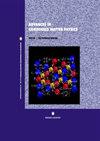Computational Study of the Effect of the Size-Dependent Dielectric Functions of Gold Nanomaterials on Optical Properties
IF 1.5
4区 物理与天体物理
Q3 PHYSICS, CONDENSED MATTER
引用次数: 0
Abstract
The effect of size on the optical properties of gold nanomaterials has been studied using the theoretical Drude–Sommerfield model. The real and imaginary parts of the dielectric function of bulk as a function of wavelength due to free electron contribution and the real and imaginary parts of the dielectric function of nanogold materials as a function of wavelength due to free electron and bond electron contribution are calculated. The real and imaginary parts of the dielectric function of bulk as a function of wavelength due to the free electron contribution graph and The real and imaginary parts of the dielectric function of nanogold materials as a function of wavelength due to free electron and bond electron contributions are plotted. As we observed from the graphs, the real dielectric functions of both bulk and nanogold materials are inversely proportional to wavelength. The imaginary part of the dielectric function of bulk gold materials is independent of wavelength. At high wavelengths, the size of the gold nanomaterial is highly influenced by both real and imagined dielectric functions at high waves. As the wavelength increases, the effect of the size on the dielectric function also increases. The size-dependent dielectric function of nanomaterials is highly influenced by their optical properties and electrical structure.金纳米材料尺寸相关介电函数对光学特性影响的计算研究
利用德鲁德-索默菲尔德理论模型研究了尺寸对纳米金材料光学特性的影响。计算了自由电子贡献导致的块体介电函数随波长变化的实部和虚部,以及自由电子和键电子贡献导致的纳米金材料介电函数随波长变化的实部和虚部。绘制了块体介电函数的实部和虚部与自由电子贡献波长的函数关系图,以及纳米金材料介电函数的实部和虚部与自由电子和键电子贡献波长的函数关系图。从图中我们可以看出,体金和纳米金材料的介电函数实部与波长成反比。块状金材料介电函数的虚部与波长无关。在高波长下,纳米金材料的尺寸受高波实部介电函数和虚部介电函数的影响很大。随着波长的增加,尺寸对介电常数的影响也在增加。纳米材料随尺寸变化的介电常数受其光学特性和电气结构的影响很大。
本文章由计算机程序翻译,如有差异,请以英文原文为准。
求助全文
约1分钟内获得全文
求助全文
来源期刊

Advances in Condensed Matter Physics
PHYSICS, CONDENSED MATTER-
CiteScore
2.30
自引率
0.00%
发文量
33
审稿时长
6-12 weeks
期刊介绍:
Advances in Condensed Matter Physics publishes articles on the experimental and theoretical study of the physics of materials in solid, liquid, amorphous, and exotic states. Papers consider the quantum, classical, and statistical mechanics of materials; their structure, dynamics, and phase transitions; and their magnetic, electronic, thermal, and optical properties.
Submission of original research, and focused review articles, is welcomed from researchers from across the entire condensed matter physics community.
 求助内容:
求助内容: 应助结果提醒方式:
应助结果提醒方式:


